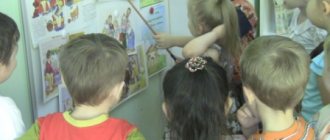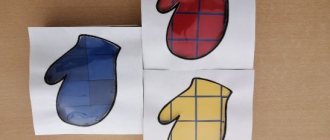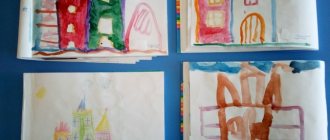Topic “CHILD SAFETY ON THE STREET”
Contents of the work: acquaintance with the street, transport, zebra crossings, traffic lights, basic rules of behavior on the street.
Cognitive practical activity. Targeted walk down the street
Goal: to clarify children’s ideas about the street, the rules of behavior on it and types of transport.
While walking along the street, the teacher reinforces the children's ideas about the names of the locality and the street they are walking on, and talks about the rules of safe behavior on the street. Informs about the structure of the street: there are houses on both sides, they are separated by a wide road (roadway), along which different cars drive.
On both sides of the roadway there are narrow paths for people (sidewalks). For safety, the roadway is separated from the sidewalk by a curb and a lawn. Children name the transport that is moving (bus, car, minibus, ambulance, trolleybus, tram, truck, etc.). During walks, the teacher develops the ability to see beauty in the environment.
Artistic activity. Construction of “City Street”
Goal: to consolidate children’s ideas about the street.
Material: large construction sets, dolls, cars, fences, trees.
With the help of bars, children lay out wide and narrow paths, clarifying their purpose. Various houses are built from bricks, cubes, and prisms, and the construction is supplemented with details. Together they come up with a name for the street. They use toys to play with the building.
Cognitive practical activity. Introducing ways to cross the street
Goal: to consolidate children’s ideas about the structure of the street and basic traffic rules.
Material: model of a city street with a pedestrian crossing, a set of toys (figurines of people, cars, model of a traffic light).
Q. Guys, we are on the street. Tell me what do you see? (Houses, a wide road with cars on it, a narrow road for people.) What separates the roadway from the pedestrian path. (Border, lawn.) Where are the cars? (On the roadway.
) Is it possible for pedestrians to enter the roadway? Why? (Children's answers.) Can children go outside without adults? (No. It's dangerous.) What if a pedestrian needs to cross to the other side of the street? (Children's answers.
) What do red, yellow, green traffic lights mean? (Children's answers.)
Emphasize that pedestrians have assistants for safety: a pedestrian crossing and a traffic light. The traffic light has three color signals: if it is red, you cannot move; if the yellow signal is on, this means that you need to get ready to move so as not to delay anyone; If the green signal is on, movement is allowed. At the pedestrian crossing, cars stop to let people through.
Game activity. Didactic game “Walk down the street”
Goal: to consolidate children’s ideas about the structure of the street and places for pedestrians to move.
Material: small construction set, dolls, animals, cars, trees, wide and narrow strips of paper.
Progress of the game
Children are invited to build a street from a construction set, name its parts, places for pedestrians and cars to move. Then the children act out various situations of crossing the street.
Game activity. Outdoor game “Colored Cars”
Goal: developing the ability to respond to a signal by changing the direction of movement.
Material: multi-colored rudders and flags.
Progress of the game
Children (cars) are placed along the wall or along the edge of the site, each with their own steering wheel color. The presenter has a set of flags of the same colors as the steering wheels. He raises the flag. Children with the same color steering wheel run around imitating the movement and sound of a car.
When the leader lowers the flag, they stop and go to the garage. Children's attention is drawn to moving carefully and avoiding accidents. To complicate the game, the presenter can raise 1-3 flags at the same time.
Cognitive practical activity. Traffic light monitoring
Goal: to consolidate children’s understanding of how traffic lights work and the rules of behavior on the street.
During the walk, the teacher asks the children to remember the name of the city, their street. Draws attention to the diversity of passenger transport in the city.
When approaching a pedestrian crossing, remind them that traffic lights are installed at intersections and pedestrian crossings. They do this so that cars and pedestrians do not interfere with each other, they know when and who can cross the street, so that it is safe.
The guys look at the traffic light, name the colors of its signals and their meaning. Monitor the movement of cars and pedestrians. Pay attention to the fact that there are many cars and trucks moving along the road, and no one interferes with each other.
This is because drivers follow traffic rules. Pedestrians also obey traffic lights. Children remember that the carriageway of the street is intended for cars, the sidewalk is for people, and they establish the rules: pedestrians can cross the street only at a pedestrian crossing, when the traffic light is green, pedestrians are not allowed to enter the roadway.
The teacher summarizes the rules of behavior on the street: you need to cross the road hand in hand with an adult, you cannot run or play. At the kindergarten site, he organizes the game “Children and the Traffic Light”: when the teacher shows a green circle, the children walk and run around the site, when it is red, the children stop and stand.
Communication. Conversation on the poem “Ball” by S. Marshak
Goal: to consolidate ideas about the rules of behavior on the street.
The teacher reads the poem “Ball” by S. Marshak to the children, then asks questions:
-What is this poem about? (Children's answers.)
— Why did the ball burst? (Rolled out onto the road and fell under the wheels of a car.)
— Is it possible to play with a ball on the street? (Children's answers.)
- Why can’t we play outside? (Is it dangerous.)




